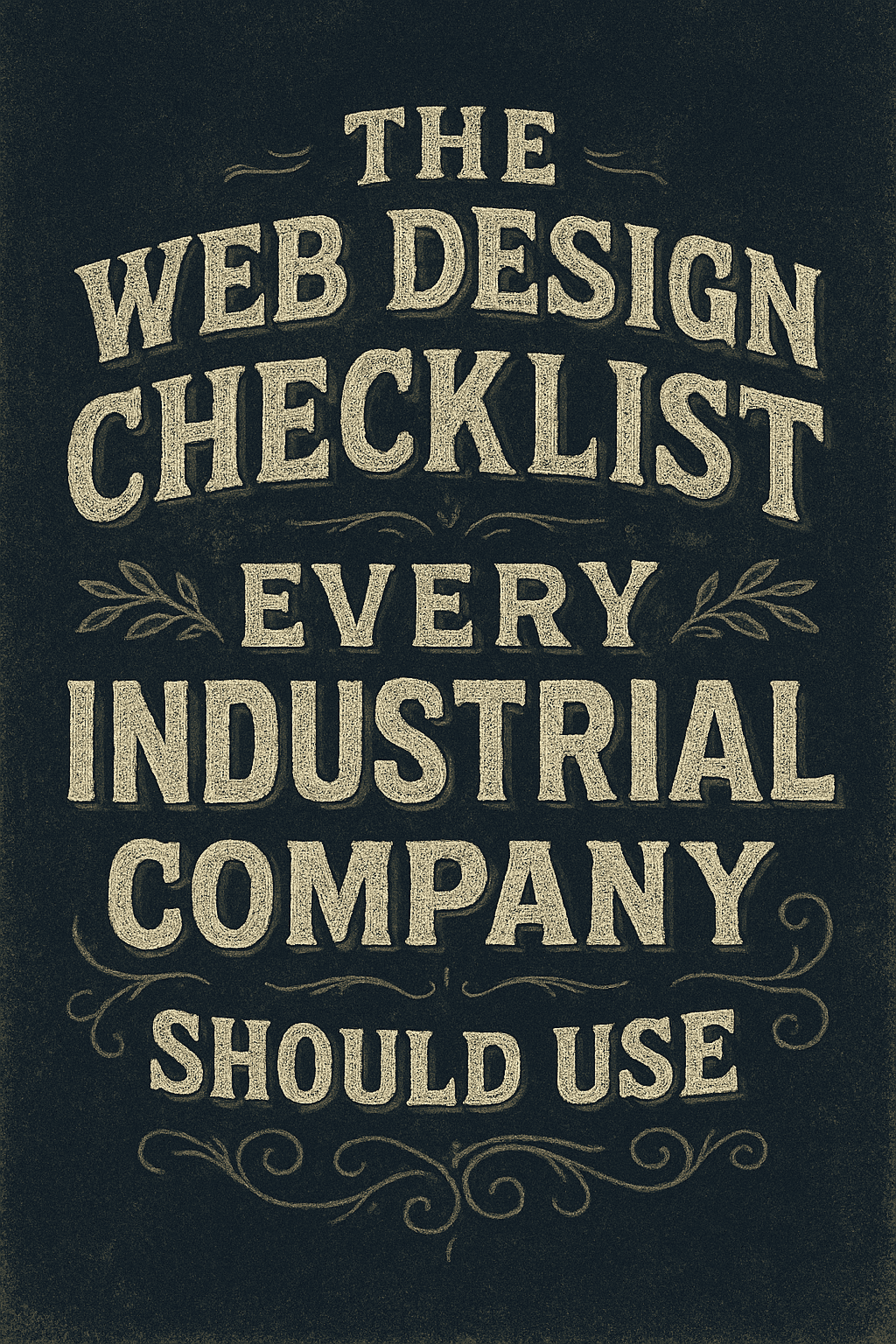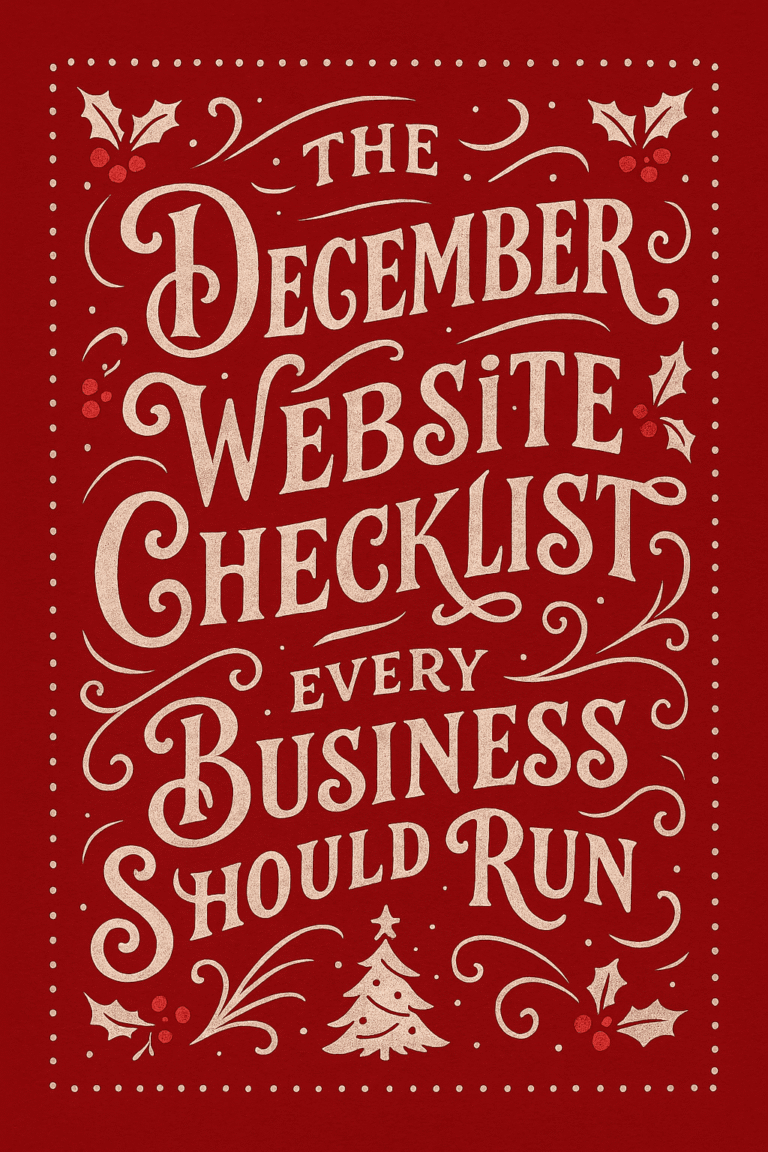
If you’re in the industrial sector—manufacturing, distribution, supply, or services—your website probably wasn’t built with modern users or SEO in mind. Many industrial companies rely on outdated websites, unclear messaging, or overly technical content that turns off buyers and confuses search engines. In 2025, that’s no longer sustainable. If your website is clunky, invisible on Google, or hard to navigate, it’s holding your business back.
This post gives you a detailed, no-fluff checklist for building or updating a website that actually works. We’re talking about lead generation, trust-building, mobile performance, and search rankings—all tuned for the industrial audience. Bookmark this, share it with your team, and refer back to it as you improve your online presence.
1) Clear Purpose & Messaging
Start with clarity. Visitors should immediately understand what your business does, who it helps, and why they should choose your solution over someone else’s. Avoid language that’s too generic. A headline like “Innovative Solutions for Industry” doesn’t say anything concrete. Instead, use copy like “Custom Metal Fabrication for Heavy Equipment Manufacturers.” Make the value clear at a glance. Also consider adding a tagline under your logo or in your header that reinforces your primary offer.
Below the fold, reinforce your message with a short paragraph that describes your capabilities and key differentiators. Do you deliver faster? Offer more customization? Carry hard-to-find parts? Spell it out. This is your first impression—don’t waste it.
2) Fast Load Speed
Your website’s speed impacts both user experience and search engine rankings. A slow site drives away visitors and gives the impression of a company that’s behind the times. Use a performance testing tool to measure your current load time and identify slow-loading assets. Aim for under three seconds.
Compress images before uploading them. Avoid using oversized photos taken directly from phones or cameras. For visual assets like logos or icons, use vector formats like SVG. Use lazy loading for below-the-fold content and minimize the number of HTTP requests your site makes. Choose a quality host that doesn’t cram hundreds of sites onto the same server.
3) Mobile Usability
Even if your customers are in the field or the shop, they’re using phones and tablets. Your site needs to work well on all devices. A mobile-friendly site not only helps with SEO but also increases lead conversions by making it easier for people to contact you or fill out a form on the go.
Check your layout on multiple screen sizes. Test navigation, buttons, text sizing, and spacing. Can users read specs and request a quote without pinching and zooming? Make sure forms are short and easy to complete, with clear labels and a logical flow. Remove unnecessary steps or fields that might turn people away.
4) Simple, Logical Navigation
Your navigation structure is the backbone of your website. Keep it simple. Group pages logically, and avoid overloading the menu with too many categories. Prioritize what your customers care about. If you offer different product categories or services, create landing pages for each. Don’t bury critical pages under vague menu titles like “Solutions.”
Use breadcrumbs to help users understand where they are. A good menu setup also supports SEO by giving search engines a clear view of your site’s hierarchy. Consider using a sticky header with navigation that remains visible as users scroll—just make sure it doesn’t obstruct content on mobile.
5) Detailed Product & Service Pages
Each product or service deserves its own page. Don’t lump them all onto one page with a bullet list. Buyers often land directly on product pages through search engines, so each one should stand on its own.
Include photos (preferably original), specifications, use cases, tolerances, compatible parts, and lead times. If your products meet certain standards or tolerances, say so. Add a downloadable PDF with technical information if your industry expects it. Include pricing if appropriate, or guide the user to request a quote. End each page with a clear call to action and optional FAQ section tailored to that product or service.
6) On-Page SEO Best Practices
Every page on your site should have a unique title tag and meta description. Include relevant keywords naturally in your headings and body text. Use alt tags for all images, not just for accessibility but also to give search engines more context.
Use structured data markup to define elements like addresses, product listings, reviews, and breadcrumbs. Link internally between related pages (e.g., a service page linking to its related case study). Optimize for long-tail keywords that reflect how your customers search, such as “bulk hydraulic hose supplier southwest Washington.”
7) Conversion-Focused Layout
Your website shouldn’t just inform—it should convert. Each page should guide the visitor toward a specific action: calling, filling out a quote request, or downloading a catalog.
Use prominent buttons, especially above the fold. Add calls to action throughout long pages, especially after key sections. Keep forms short—name, email, phone number, and a notes field is often enough. If you need more information, follow up after the lead comes in.
Use trust signals like customer logos, quotes, or performance stats (e.g., number of units shipped or uptime percentages). Add badges for certifications or quality standards. These add credibility and reduce hesitation.
8) Trust-Building Features
Your site should project reliability and capability. This is especially true in sectors where large purchases are made or long-term contracts are signed. Show that others have trusted you before.
Include testimonials that are specific. A generic “Great service!” won’t cut it. Provide names, titles, and company types where possible. Highlight industries you serve to show range. Add a photo gallery or a “projects” section that demonstrates your capabilities visually. A well-documented job or installation speaks volumes.
9) Location & Service Area Pages
If you serve specific regions, create individual pages targeting those areas. This helps you rank better in local searches. Mention the specific cities or counties you cover, along with examples of the services you’ve provided in those areas.
Include maps, driving directions, or photos of your facility if customers visit in person. Add structured data with location schema. Make sure your address and phone number are consistent with your Google Business Profile and directory listings.
10) Content That Educates
Don’t just sell—teach. Your buyers are often researching before they ever contact you. Help them make smarter decisions with content that answers their questions.
Write blog posts that explain how your services work, how to compare similar products, or how to troubleshoot common issues. Turn common sales questions into public content that saves your team time. Create downloadable resources such as checklists, spec guides, or calculators. Not only do these help users, they also earn backlinks and improve SEO.
11) Strong Visuals
In industrial sectors, visuals can make or break trust. Use actual photos of your facility, products, or team whenever possible. If you provide fabrication, machining, or installation services, show the work in progress and completed.
Use diagrams or illustrations to explain complex processes. Include before-and-after comparisons. Avoid using generic stock photos, which feel disconnected and impersonal. Clean, well-lit photography goes a long way in building professionalism and confidence.
12) Secure & Accessible
HTTPS is mandatory. Security certificates not only protect your site, they signal to users that you’re a credible business. Many browsers now warn users when a site isn’t secure, which can cause drop-offs.
Accessibility helps both users and search engines. Make sure all images have alt tags. Use proper heading structure (H1, H2, H3). Ensure color contrast meets accessibility standards. Allow for keyboard navigation and test with screen readers when possible. Even small improvements make your site more usable for more people.
13) Platform & CMS Selection
The backend of your site matters too. Choose a platform that fits your team’s technical ability and growth needs. If you need to update pricing, add new product lines, or adjust form settings regularly, choose a system that makes those changes easy without needing a developer every time.
Look for CMS options that support SEO customization, speed optimization, and easy plugin integration. Avoid bloated systems that slow your site down. If you’re using WordPress, be selective about which plugins you use, and audit performance regularly.
14) Multilingual Options
If you serve clients across borders or work with multilingual crews, consider building a bilingual or multilingual site. This can dramatically improve communication and customer experience. Use professional translation—not auto-translate—to ensure clarity and technical accuracy.
Make language switching intuitive, and mirror your site’s content structure in each language. Use hreflang tags to signal to search engines which version to show to which audience.
15) Frequently Asked Questions (FAQs)
An FAQ section helps users find answers fast and reduces support inquiries. Place one on key pages—especially service, product, and contact pages. Questions should reflect what your prospects ask during sales calls, site visits, or email inquiries.
Write each answer in simple language. Avoid overly technical terms unless your audience expects them. Use accordions or toggle sections to keep the design clean. Link to deeper resources where appropriate. This section is also a great place to include keywords naturally.
16) Website Maintenance & Updates
Keeping your website maintained is just as important as launching it. Industrial websites that go years without updates quickly show their age—not just in design but also in compatibility, functionality, and security. Outdated themes or plugins can lead to broken features and vulnerabilities.
Set a recurring review schedule. At least once per quarter, check for outdated content, broken links, old product specs, and plugin or system updates. If you’re working with a web partner, ensure they’re proactively maintaining performance and backups. A site that appears neglected signals the same about your business.
17) Performance Monitoring & Reporting
It’s not enough to launch a new site and hope it performs. You need to measure and improve continuously. Set up Google Analytics, Google Search Console, and tools like uptime monitors and page speed trackers. Check performance dashboards monthly and compare metrics against goals.
Are people spending time on your key service pages? Are they bouncing quickly from the homepage? Which calls to action convert best? This data should guide what you adjust—whether that’s a better headline, a more prominent quote button, or reorganizing the main menu.
18) Document Downloads & Asset Tracking
Many industrial buyers rely on technical documentation like product sheets, CAD drawings, safety data, or installation guides. Make sure these are organized, easy to download, and kept up to date. You can also track downloads using analytics tools to understand what’s getting used and what isn’t.
Organize resources by product type or service area. Label them clearly and use descriptive file names (not just “specs.pdf”). Add a short description of each file’s purpose to help visitors know what to expect before downloading.
19) Career & Employment Opportunities
Recruiting is a big challenge in the industrial world. Your website is a great tool to attract talent if used well. Add a Careers page—even if you’re not currently hiring—so job seekers know where to look. Post clear job descriptions, expected qualifications, and how to apply.
Include photos of your team, facility, and workplace culture. You can also feature employee testimonials or explain your training process. People want to work with a company that has stability, values, and opportunity for growth. Make that visible.
20) Environmental & Safety Information
In many industrial sectors, safety and environmental compliance matter deeply to your customers. If applicable, dedicate a section to this. Outline your safety procedures, certifications, or environmental policies. Share your safety record, or at least show that you prioritize compliance and responsible practices.
Offer downloadable safety documents or compliance sheets where required. If you use specific processes or equipment that exceed standards, mention them here. It builds trust and helps you stand out—especially for contracts requiring documentation before approval.
Now that you’ve walked through the full checklist—from technical foundations to marketing and recruiting—it’s time to act. The companies that take their website seriously are the ones that get seen, get leads, and win more business.
Next Steps
Review your site section by section. Start with the areas that have the most business impact—typically product pages, contact forms, and service descriptions. Then work your way through improvements to design, content, and performance. If you’re not sure where to begin or don’t have the bandwidth to tackle it all, we’re here to help.
At Graticle Design, we work with industrial companies who want a website that works just as hard as they do. Whether you need a site overhaul, better performance, or simply want to talk about what’s possible, contact us today.





